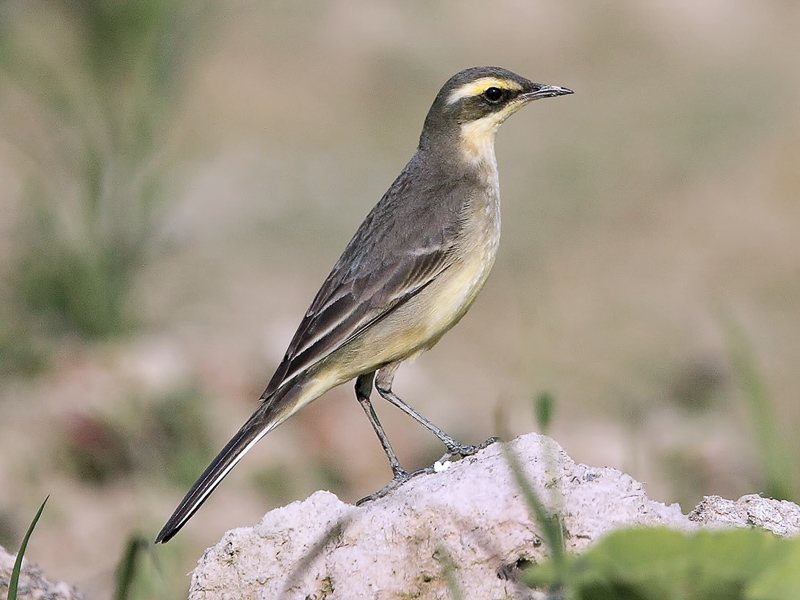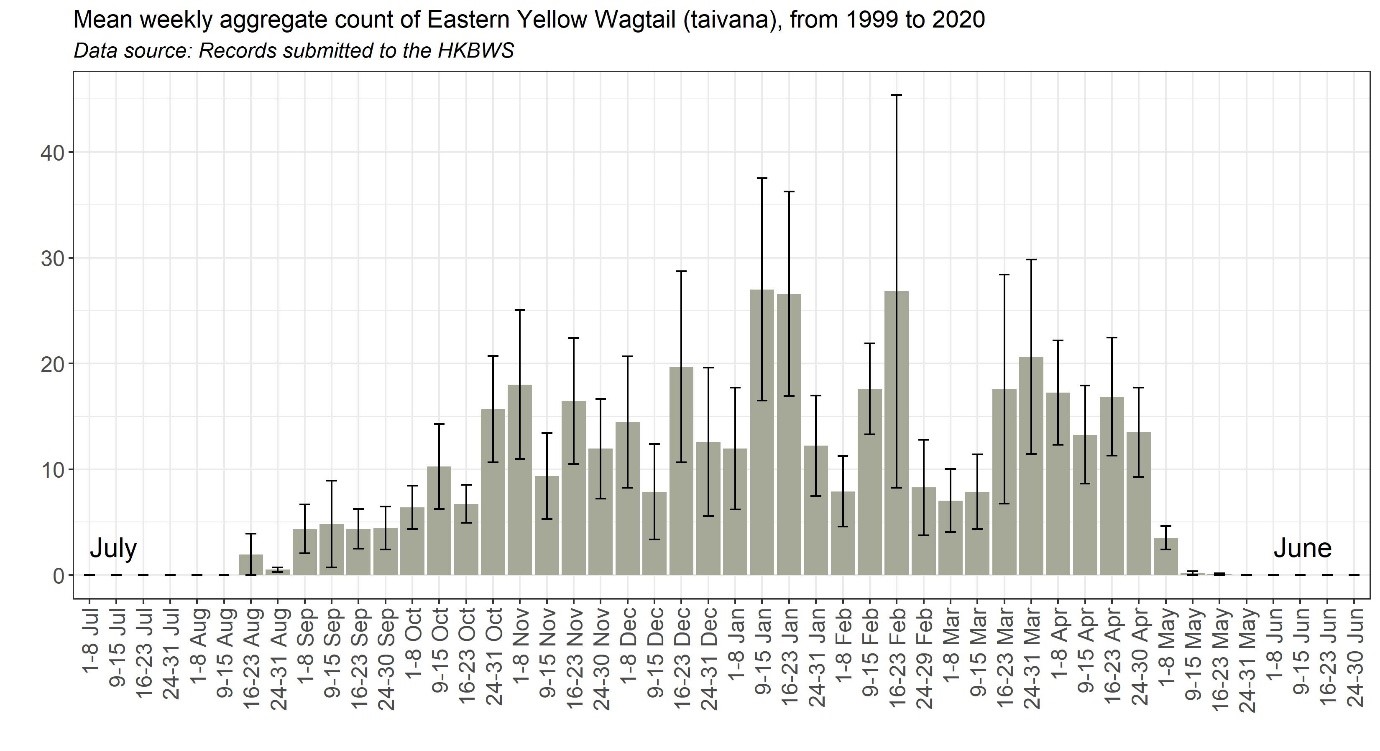Eastern Yellow Wagtail Motacilla tschutschensis taivana 東黃鶺鴒
Category I. M. t. taivana is a common passage migrant and winter visitor.
IDENTIFICATION

Nov. 2021, Michelle and Peter Wong. Adult male.
17 cm. Adult male in breeding plumage has dull greyish-green crown, nape (hence the name ‘Green-headed Wagtail’) and upperparts, long and broad yellow supercilium (slightly narrower in front of the eye and square-cut at the rear) and, usually, solidly dark ear coverts, slightly darker than crown. Adult female in breeding plumage is a duller and paler version of the male, often with a narrower supercilium. Adults in non-breeding plumage are duller, browner and paler than the respective sexes in breeding plumage (Alström et al. 2003).

Nov. 2021, Michelle and Peter Wong. First-winter.
First-years have a whitish or pale buffish supercilium (still relatively broad and long with a blunt rear end), greyer upperparts and mainly whitish underparts, often with yellowish around the vent and undertail coverts. Although the upperparts often have an olive tinge, birds completely lacking green and yellow are common.
VOCALISATIONS
The typical flight call of the three commonly-occurring Eastern Yellow Wagtail taxa in HK is a rather harsh ‘tzeep’ that falls in pitch terminally and is similar to that of Citrine Wagtail.
The alarm call, usually uttered when perched, is slightly higher-pitched, thinner and more buzzing.
DISTRIBUTION & HABITAT PREFERENCE
All taxa of Eastern Yellow Wagtail frequent low-lying marshy areas, wet agricultural areas, fish ponds, reclaimed areas and other open country habitats, mainly in the northwest New Territories. There was a decrease in the percentage of occupied 1km squares between the winter atlas surveys of 2001-05 and 2016-19 from 3.6% to 2.9%; the declines occurred in village edge or coastal areas away from Inner Deep Bay.
OCCURRENCE
M. f. taivana is the most numerous of the Eastern Yellow Wagtail taxa all year apart from late spring. It is generally present from September to April, with numbers rising to a peak midwinter, falling at the end of February but rising again during spring passage from the third week of March to the last week of April (Figure 1). Extreme dates are 26 August 2003 and 18 May 2011.
Autumn passage is unremarkable, and it is not until the last week of October that it becomes frequently reported, presumably as wintering birds arrive. It may be that the difficulty of identifying first-winter birds of the Eastern Yellow Wagtail taxa results in numbers being under-reported. The highest early autumn count is 140 at Long Valley on 14 October 1995.
It is most numerous in winter with the highest count being 1,000 Eastern Yellow Wagtails, largely this taxon, coming to roost at Mai Po on 30 January 1988 and 12 February 1989; the next highest single-site winter count (and the highest since 1999) is 400 at Hoo Hok Wai on 16 February 2010.
Spring passage occurs from in mid-March to the end of April. The highest spring count was made at Mai Po on 17 April 1992, when most of the 250 Eastern Yellow Wagtails seen were of this race; the highest spring count since 1999 is 124 on 20 March 2010.
Herklots (1934, 1953) considered taivana to be a rare winter visitor, while Dove and Goodhart (1955) did not mention it. Macfarlane and Macdonald (1966) stated taivana was a common passage migrant and quite a common winter visitor.
BEHAVIOUR, FORAGING & DIET
Forages on invertebrates on the surface of mud and plants, but no details. Walks and runs pumping tail, but less intensely than White and Grey Wagtails. Flight seems slightly weaker than that of White Wagtail, more closely resembling that of pipits. Generally showy and vocal, if not very approachable. More likely than White Wagtail to occur in flocks on migration and when foraging.
RANGE & SYSTEMATICS
M. t. taivana breeds in southeast Siberia, Amurland, Sakhalin and north Japan; it winters from south China, including Hainan and Taiwan, through southeast Asia as far as the Greater Sundas and Wallacea (Badyaev et al. 2020, Liu and Chen 2020).
Eastern Yellow Wagtail M. tschutschensis comprises four subspecies: plexa, tschutschensis, macronyx and taivana.
CONSERVATION STATUS
IUCN (Motacilla tschutschensis): Least Concern. Population trend decreasing.
Figure 1.

Alström, P., K. Mild and B. Zetterström (2003). Pipits and Wagtails of Europe, Asia and North America. Christopher Helm, London.
Badyaev, A. V., B. Kessel, D. D. Gibson, J. del Hoyo, and N. Collar (2020). Eastern Yellow Wagtail (Motacilla tschutschensis), version 1.0. In Birds of the World (S. M. Billerman, Editor). Cornell Lab of Ornithology, Ithaca, NY, USA. https://doi.org/10.2173/bow.eaywag.01
Dove, R. S. and H. J. Goodhart (1955). Field observations from the Colony of Hong Kong. Ibis 97: 311-340.
Herklots, G. A. C. (1953). Hong Kong Birds. South China Morning Post, Hong Kong.
Herklots, G. A. C. (1934). The birds of Hong Kong. Part XVI. Family Motacillidae (Pipits and wagtails). Hong Kong Naturalist 5: 163-169.
Liu, Y. and Y. H. Chen (2020). The CNG Field Guide to the Birds of China (in Chinese). Hunan Science and Technology Publication House, Changsha.
Macfarlane, A. M. and A. D. Macdonald, revised by Caunter, J. R. L. and A. M. Macfarlane (1966). An Annotated Check-list of the Birds of Hong Kong. Hong Kong Bird Watching Society, Hong Kong.

